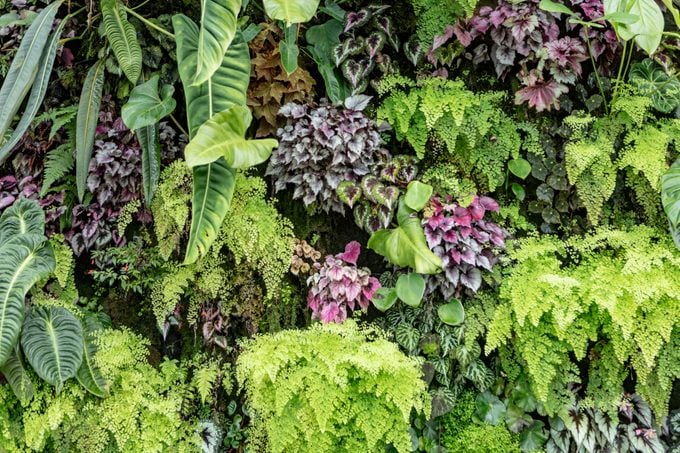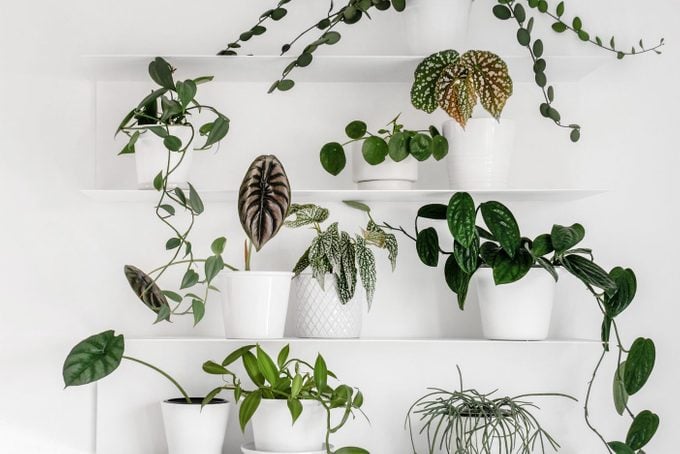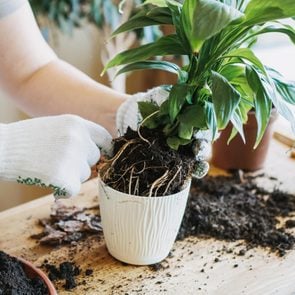How to Create a Living Wall That Brings the Outdoors In
Updated: Mar. 13, 2024

Check out these surprisingly simple tips and tricks to grow a living wall in your home. It's truly easier than you think—and absolutely stunning!
You don’t have to be a plant expert to obsess about a living wall—these vertical gardens are super cool! A living wall brings the outdoors in with a cascade of indoor plants. The result is a living work of art that transforms as it grows, and a stunning decor element that elevates any space. Gennaro Brooks-Church, who founded Eco Brooklyn to install living plant walls, says it best: “To be able to put hundreds of plants on a wall? It’s like magic.”
That vertical plant magic begins with a relatively simple guideline: Be mindful of light and water. A living wall will need both, and you’ll also need something to protect your actual wall. Most living walls include easy-to-find low-maintenance plants and low-light indoor plants, since they are tried-and-true household staples. Once the system is installed, maintenance can be relatively routine with regular watering, pruning and occasionally addressing a dead plant.
Beyond bringing good looks and joy, a living wall can also muffle sound and improve your health and sense of well-being. So why not grow for it? Here’s what you need to know before you decide to create one in your own home.
What is a living wall?
Simply put, a living wall, or green wall, arranges and grows plants vertically. The practice has ancient roots indoors and outdoors, but in modern times, indoor living walls have grown more captivating. Some gardens are tiny, others massive. Most are framed to help maintain the form and include a backing of protective material, and that waterproof membrane is critical to prevent mold and structural damage. The plants are suspended in pockets of specially designed growing material or containers, depending on the desired look. The options are always expanding, and more elaborate systems include integrated watering.
What are the benefits of a living wall?
In addition to the joy of indoor gardening, living walls can make a healthier home. During photosynthesis, plants absorb carbon dioxide and produce oxygen. Adding air-purifying plants in a room can clean the air and help us breathe better even without a wall, but the scale of a living wall takes it to a whole new level.
Some studies suggest a living wall also helps with stress reduction. Brooks-Church believes a living wall is psychologically beneficial. “People say they feel more calm and at peace when they have a living wall,” he says. With six plants per square foot, a 10-by-10-foot wall hosts 600 plants, which produces quite of bit of air-filtering and mental healing!
What should you consider before installing or growing one?
Before investing in a living plant wall, consider your budget. A DIY approach can save dollars, especially if you’re handy. A professionally installed, more self-sufficient model may run into thousands of dollars. Either way, understanding the mechanics will protect your home and preserve your plants.
Also think about the type of system that will work for you. Do you prefer to grow plants in soil or water? How much time and energy can you commit to maintaining it? Hand-watering is sloppy and time-consuming. Installing more permanent irrigation from a refillable well or more permanent water connection works efficiently, but it also jacks up the budget.
Requirements for a living wall
Before you install a vertical garden, consider your space, says Paris Lalicata, plant education and community engagement associate at The Sill. Where are the windows located? How close will they be to your indoor garden? Will the garden be large enough to require permanent watering? How hot and humid is the room through all four seasons? Here’s a closer look at two of those essential components.
Sunlight
Successful plant nurturing goes back to the old adage “location, location, location.” Since natural light is the gold standard, try to create a green wall near a window. Even low-light-loving plants need some sunshine, so supplement with grow lights if necessary. Indoor grow lighting is designed for specific plant needs and will vary. Look for a full-spectrum light system suspended from above to help provide what a room is missing naturally.
Wall types
Wall material won’t matter nearly as much as the system that delivers water and the amount of light in a room. In fact, any type of wall can support a vertical garden as long as the structure is securely attached. Larger gardens will have more weight, but for home installs, Brooks-Church says it is similar to balancing a piece of art. The key for hanging, regardless of garden size and substrate, is locating the studs in the wall and choosing the correct anchor for the type of wall.
Best plants for an indoor wall

What grows together, goes together. All your living wall indoor plants should share the same growing requirements. Since most indoor living walls are not in direct sun, think low-light plants. Brooks-Church uses mostly 3- or 4-inch containers of tropicals to start, keeping most in their original growing medium. His favorites include anthurium, peace lilies and ferns, including the Boston fern, which may need a trim as it grows. Orchids provide a flowering option.
For plenty of cascade, Lalicata loves pothos, heart leaf philodendron and peperomia. But check to see which plants are poisonous to dogs or toxic to cats before you buy. And to ensure a vertical garden is safe for the family, she says, “keep the bottom part pet-friendly and nontoxic.” Calathea, staghorn ferns and bird’s nest ferns are all fur-baby approved.
How to care for the plants on an indoor wall
Just like plants in any other setup, living wall plants need water. A permanent connection and flexible piping can distribute water throughout the structure, and some systems use a tank that needs to be filled regularly instead. Watering by hand can be a little sloppier, and it takes extra time. Either way, a waterproof catch basin or gutter should be used to protect the floors. Fertilizer should also be added to the water a couple of times a year.
And then it’s the power of observation. Stunted plants may need more light. Wilting plants could possibly use more water. Confirm the water tank or connection is active before leaving for vacation.
How to maintain a living wall
With proper plant choices, regular watering and enough light, a living wall should thrive. Check to make sure water is reaching all the plants. And keep in mind that the location and amount of light are equally important to their health. To supplement nature, install grow lights from the ceiling.
Replace plants that expire, and trim others if they outgrow their space. Cuttings from creeping beauties like pothos can be propagated to make new additions. Simply add them to water in order to root.
As for hazards, beware of plant hitchhikers! Fungus gnats may proliferate in soil-based plants. Scale, mealybugs and spider mites are possible as well. To combat these pesky pests, Sill’s Lalicata prefers insecticidal soaps and biological controls, including beneficial insects, over toxins.
What to know before you grow a living wall

- A true green wall is difficult to move, so consider how long you will live in your home before committing.
- Start small. Prefab options or a series of hanging containers can work as long as water doesn’t impact the wall.
- If a living wall seems overwhelming, use a stack of shelves filled with a wide variety of plants. You’ll get the look—but with less investment and worry. Plus, they can move when you do.
- Vertical garden ideas include edible plants too. With enough light, herbs makes a unique statement and a tasty piece of art.
- For renters and the commitment averse, preserved moss walls and faux living walls can substitute. Add real potted plants to the mix.
Sources:
- Gennaro Brooks-Church, founder of Eco Brooklyn Living Walls
- Paris Lalicata, plant education and community engagement associate at The Sill
- Urban Blooms: “The Benefits of Living Walls in Healthcare”
- SolTech: “How to Choose Lighting for Your Indoor Plant Wall”
- Dwell: “Living Green Walls 101: Their Benefits and How They’re Made”





















